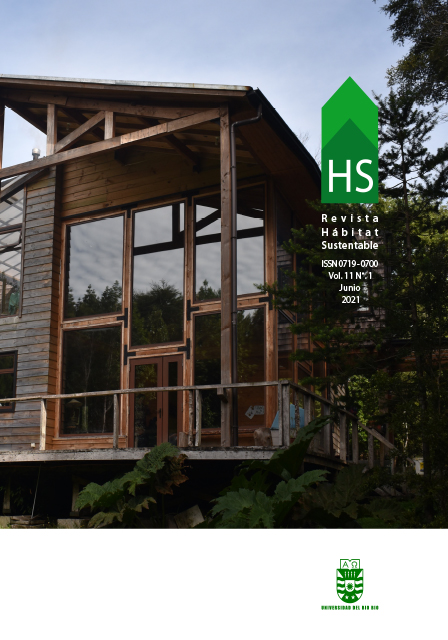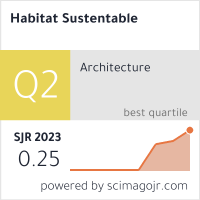Aplicación de la “Footprint Family” para la evaluación ambiental de edificios públicos en España. Estudio de caso: centro educativo.
DOI:
https://doi.org/10.22320/07190700.2021.11.01.06Palabras clave:
Ingeniería de la construcción, impacto ambiental, indicadores ambientalesResumen
Dentro de los compromisos de la Agenda 2030, destacan los objetivos socioeconómicos para un desarrollo sostenible del conjunto de la sociedad, que plantean minimizar el impacto producido por la Administración Pública sobre el medio ambiente en todas sus actividades. Por ello, la creación y reforma de sus infraestructuras, necesarias para su funcionamiento y los servicios que presta, supone un gran impacto. El objetivo del presente trabajo se centra en una adaptación metodológica para evaluación ambiental de las obras promovidas por entes públicos, cuantificando y localizando los focos de impacto para poder tomar las medidas que los minimicen. Para ello, se proponen como indicadores la familia de las huellas, ecológica, de carbono e hídrica, caracterizadas por la simpleza del mensaje y la facilidad para implantarse en el sector de la construcción, a través del control de costes de los proyectos. En concreto, se presenta un estudio de caso, la construcción de un centro de educación infantil en la ciudad de Madrid, para cuyo análisis se exponen y analizan los datos necesarios. Los resultados reflejan información interesante, en términos de huellas, sobre los elementos que deben ser controlados y mejorados en el diseño del proyecto, tales como el hormigón y acero.
Descargas
Citas
ALLAN, J. A. (1993). Fortunately there are Substitutes for Water Otherwise our Hydro-political Futures would be Impossible. En Priorities for Water Resources Allocation and Management (13-26). London: ODA.
ALMASI, A. M. Y MILIOS, L. (2013). Municipal waste management in Spain. European Environment Agency. Recuperado de https://www.eea.europa.eu/ds_resolveuid/UD8Z6VW5GB
BARBERO ARRABÉ, I. (2018). Proyecto de construcción de Centro de Educación Infantil. Madrid: Centro de Proyectos del Ejército. Dirección de Infraestructura (DIIN).
BARE, J., HOFSTETTER, P., PENNINGTON, D.W. Y UDO DE HAES, H.A. (2000). Life cycle impact assessment workshop summary. Midpoints versus endpoints: the sacrifices and benefits. International Journal of Life Cycle Assessment, 5(6), 319-326.
BELTRÁN, M. J. Y VELÁZQUEZ, E. (2015). La ecología política del agua virtual y huella hídrica. Reflexiones sobre la necesidad de un análisis crítico de los indicadores de flujos virtuales de agua en la economía. Revista de Economía Crítica, (20). Recuperado de http://www.revistaeconomiacritica.org/node/770
COMISIÓN NACIONAL DEL MERCADO Y LA COMPETENCIA (2019). Radiografía de los procedimientos de contratación pública en España. Madrid: Comisión Nacional de los Mercados y la Competencia. Recuperado de https://www.cnmc.es/expedientes/ecnmc00418
CHASTAS, P., THEODOSIOU, T., KONTOLEON, K. J. Y BIKAS, D., (2018). Normalizing and assessing carbon emissions in the building sector: A review on the embodied CO2 emissions of residential buildings. Building and Environment, 130, 212–226. DOI: https://doi.org/10.1016/j.buildenv.2017.12.032
CRAWFORD, R. H. Y PULLEN, S. (2011). Life cycle water analysis of a residential building and its occupants. Building Research and Information, 39(6), 589-602. DOI: https://doi.org/10.1080/09613218.2011.584212
DOSSCHE, C., BOEL, V. Y DE CORTE, W. (2017). Use of life cycle assessments in the construction sector: critical review. Procedia Engineering, 171, 302-311. DOI: https://doi.org/10.1016/j.proeng.2017.01.338
ECOINVENT CENTER (2013). Ecoinvent database v3 Ecoinvent Report. Recuperado de www.ecoinvent.org
EMASESA (2005). Sostenibilidad y Gestión. Éramos así, así somos (1975-2005). Recuperado de https://www.emasesa.com/asi-eramos-asi-somos-1975-2005/
FÉRRIZ PAPÍ, J.A. (2012). Water consumption in buildings: Embebed water in construction materials. Trabajo presentado en 1st International Congress on Water, Waste and Energy Management. Salamanca. Recuperado de https://www.researchgate.net/publication/277716798_Water_Consumption_in_Buildings_Embebed_Water_in_Construction_Materials
FREIRE GUERRERO, A., ALBA RODRÍGUEZ, Mª D. Y MARRERO MELÉNDEZ, M. (2019). A budget for the ecological footprint of buildings is possible: a case study using the dwelling construction cost database of Andalusia. Sustainable Cities and Society, 51. DOI: https://doi.org/10.1016/j.scs.2019.101737
FREIRE GUERRERO, A. Y MARRERO, M. (2015a). Ecological Footprint in Indirect Costs of Construction. Proceedings of the II International congress on sustainable construction and eco-efficient solutions: Seville 25-27 may 2015 (pp. 969-980). Recuperado de http://hdl.handle.net/11441/59685
FREIRE GUERRERO, A. Y MARRERO, M. (2015b). Evaluación a través del presupuesto de la energía incorporada al proyecto de edificación. Revista Hábitat Sustentable, 5(1), 54-63. Recuperado de http://revistas.ubiobio.cl/index.php/RHS/article/view/1812
FUNDACIÓN GENERAL DE LA UNIVERSIDAD COMPLUTENSE DE MADRID (2010). Cambio Global España 2020/50. Sector edificación. Programa Cambio Global España 2020/50 del Centro Complutense de Estudios e Información Medioambiental. Madrid.
GENG, R., MANSOURI, A. Y AKTAS, E. (2017). The relationship between green supply chain management and performance: A meta-analysis of empirical evidences in Asian emerging economies. International Journal of Production Economics, 183, 245–258. https://doi.org/10.1016/j.ijpe.2016.10.008
GONZÁLEZ VALLEJO. P, MUÑOZ SANGUINETTI C. Y MARRERO MELÉNDEZ, M, (2019). Environmental and economic assessment of dwelling construction in Spain and Chile. A comparative analysis of two representative case studies. Journal of Cleaner Production, 208, 621-635. DOI: https://doi.org/10.1016/j.jclepro.2018.10.063
GONZÁLEZ VALLEJO, P. (2017). Evaluación económica y ambiental de la construcción de edificios residenciales. Aplicación a España y Chile. Tesis doctoral de Arquitectura, Universidad de Sevilla.
GONZÁLEZ VALLEJO, P., MARRERO, M. Y SOLÍS GUZMÁN, J. (2015). The ecological footprint of dwelling construction in Spain. Ecological Indicators, 52, 75-84, DOI: http://dx.doi.org/10.1016/j.ecolind.2014.11.016.
GRUNEWALD, N., GALLI, A., KATSUNORI, I., HALLE, M. Y GRESSOT, M. (2015). The Ecological Footprint of Mediterranean Diets. Recuperado de https://www.researchgate.net/publication/275349456_The_Ecological_Footprint_of_Mediterranean_Diets
IDAE (2011). Factores de Emisión de CO2. Recuperado de https://www.idae.es/informacion-y-publicaciones
INSTITUTO DE TECNOLOGÍA DE LA CONSTRUCCIÓN DE CATALUÑA (ITEC) (2013). Recuperado de http://www.itec.es/nouBedec.e/bedec.aspx (accessed on Dec 3, 2013).
KAIRIES ALVARADO, D., MUÑOZ SANGUINETTI, C. Y MARTÍNEZ ROCAMORA, A., (2021). Contribution of energy efficiency standards to life-cycle carbon footprint reduction in public buildings in Chile, Energy and Buildings, 236, DOI: https://doi.org/10.1016/j.enbuild.2021.110797
LAURENT, A. Y OWSIANIAK, M. (2017). Potentials and limitations of footprints for gauging environmental sustainability. Current Opinion in Environmental Sustainability, 25, 20-27, DOI: https://doi.org/10.1016/j.cosust.2017.04.003
MARTÍNEZ-ROCAMORA, A., SOLÍS-GUZMÁN, J. Y MARRERO, M. (2016a). LCA databases focused on
construction materials: A review. Renewable and Sustainable Energy Reviews, 58, 565-573. DOI: https://doi.org/10.1016/j.rser.2015.12.243
MARTÍNEZ-ROCAMORA, A., SOLÍS-GUZMÁN, J. Y MARRERO, M. (2016b). Toward the Ecological Footprint of the use and maintenance phase of buildings: Utility consumption and cleaning tasks. Ecological Indicators, 69, 66–77. DOI: https://doi.org/10.1016/j.ecolind.2016.04.007
MARRERO, M. Y RAMÍREZ DE ARELLANO, A. (2010). The building cost system in Andalusia: application to construction and demolition waste management. Construction Management and Economics, 28(5), 495-507. DOI: https://doi.org/10.1080/01446191003735500
MARRERO, M., RIVERO, C. Y ALBA, Mª D. (2020). What are we discarding during the life cycle of a building? Case studies of social housing in Andalusia, Spain. Waste Management: international journal of integrated waste management, science and technology, 102, 391-403. DOI: https://doi.org/10.1016/j.wasman.2019.11.002
MCCORMACK, M., TRELOAR, G.J., PALMOWSKI, L. Y CRAWFORD, R. (2007). Modelling direct and indirect water requirements of construction. Building Research and Information, 35(2), 156-162. DOI: https://doi.org/10.1080/09613210601125383
PRÉ SUSTAINABILITY (2016). Simapro 8. Recuperado de https://simapro.com/
REE (2014-2018). El Sistema Eléctrico Español / The Spanish Electric System. Recuperado de https://www.ree.es/es/datos/publicaciones/informe-anual-sistema/informe-delsistema-electrico-espanol-2018
RIVERO, C. (2020). Estudio de Huellas en el Ciclo de Vida del Edificio Residencial. Tesis Doctoral. Universidad de Sevilla.
VANHAM, D., LEIP, A., GALLI, A., KASTNER, T., BRUCKNER, M., UWIZEYE, A., VAN DIJK, K., … Y HOEKSTRA, A. (2019). Environmental footprint family to address local to planetary sustainability and deliver on the SDGs. Science of The Total Environment, 693. DOI: https://doi.org/10.1016/j.scitotenv.2019.133642
VELÁZQUEZ, E., MADRID, C. Y BELTRÁN, M. J. (2011). Rethinking concepts of virtual water and water footprint in relation to the production–consumption binomial and the water–energy nexus. Water Resources Management, 25, 743–761. DOI:10.1007/s11269-010-9724-7
ZHANG, L., DZAKPASU, M., CHEN, R. Y WANG, X. (2017). Validity and utility of ecological footprint accounting: A stateof-the-art review. Sustainable Cities and Society, 32, 411-416. DOI: https://doi.org/10.1016/j.scs.2017.04.016
Descargas
Publicado
Cómo citar
Número
Sección
Licencia
Derechos de autor 2021 Cristina Rivero-Camacho, Antonio Ferreira-Sanchez

Esta obra está bajo una licencia internacional Creative Commons Atribución-CompartirIgual 4.0.
El contenido de los artículos que se publican en cada número de Hábitat Sustentable, es responsabilidad exclusiva de los autores y no representan necesariamente el pensamiento ni comprometen la opinión de la Universidad del Bío-Bío.
Los autores/as conservarán sus derechos de autor y garantizarán a la revista el derecho de primera publicación de su obra, el cuál estará simultáneamente sujeto a la Licencia de Reconocimiento de Creative Commons CC BY-SA que permite a otros compartir-copiar, transformar o crear nuevo material a partir de esta obra con fines no comerciales, siempre y cuando se reconozcan la autoría y la primera publicación en esta revista, y sus nuevas creaciones estén bajo una licencia con los mismos términos.











 Programa de Información Científica/Concurso Fondos de Publicación de Revistas Científicas 2018/ Proyecto Mejoramiento de Visibilidad de Revistas UBB (Código:FP180007)
Programa de Información Científica/Concurso Fondos de Publicación de Revistas Científicas 2018/ Proyecto Mejoramiento de Visibilidad de Revistas UBB (Código:FP180007) 





